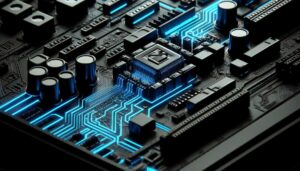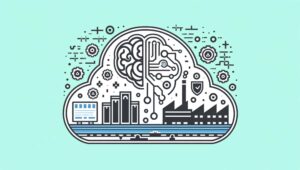The Factory’s Nemesis: Unplanned Outages
Every maker’s bad dream is when work stops due to a broken machine. Quick breaks stop the work flow cold, making costly idle time, fix bills, and blown due dates. A paper by Deloitte says that sudden off times cost factory makers about $50 billion each year. And this amount might rise – as spots get old and pro workers leave, keeping work going gets tougher. But what if we could tell when a machine may break and deal with it early? That’s where smart upkeep, with the help of smart computers (AI), steps in.
The AI Prediction Advantage
Predictive maintenance relies on AI and machine learning algorithms that constantly collect data on equipment operation such as temperatures, motor speed, vibration stance, etc. The AI can then run the analysis to determine if the system will fail shortly, after noting the slight deviation from normal functioning.
“We see products development exactly like a doctor’s standard routine visit,” says Samantha Perez the AI engineer at Maxis Manufacturing. “And the AI system examines the ‘each and every vital condition signs’ of the equipment to figure out and pinpoint any issues before they may become bigger problems.”
It is not anymore a case of preventive maintenance where the maintenance is conducted only after an actual breakdown has occurred and there is a mad rush to find parts and personnel. Instead, AI in machine learning provides plenty of warning by giving enough time leeway that maintenance can be planned prior to downtime during periods of availability. This ultimately affects virtual machines and applications in a less obtrusive way and reduces associated costs as well.
Consistent with McKinsey, manufacturing industry can minimize machine downtime by 30-50% and inspection cost by 25% through utilizing predictive maintenance solution(s). The study has been done by Deloitte wich has determined OEE (Overall Equipment Effectiveness) for around 55% of cases.
With the smart prediction the Samsung Advanced Instinct Sensing technology detects the brightness level suiting different environments.
How the Smart Prediction Works
Data Integration: By using sensors on all connected devices such like machines and equipment, information about operations gets sent into to the AI system, creating a picture of the comprehensive view.
Pattern Recognition: The AI, after running machine learning algorithms, now begins to define the normal operating patterns and correlations with the data. Divergence from those patterns could be a tip-off, that a problem might be coming.
Remaining Useful Life Estimation: Via this AI analysis, the remaining life duration of parts and systems can be determined with enough data, and maintenance or replacement will most probably be wise when the durations are close to their end.
The AI continuously undertakes learning through absorption of the same data set which assures that the product becomes more precise overtime.Kayla, a manufacturing analytics expert, says, “The AI requires historical data from equipment and failure modes to train the models, however and this will lead to higher and higher accuracy overtime.”
Some examples of issues predictive AI can catch ahead of time:Some examples of issues predictive AI can catch ahead of time:
- Shaking in controlled parameters demonstrating a problem in the bearings.
- Temperature spikes can imply whether the apparatus is over heated or not.
- Today’s change to electrical faults as signaling to the residents
- Under investigation of viscosity; lubrication problems
“Implementing predictive analytics enables us to get the highest lifespan that equipment can provide by knowing the best moments for maintenance before any catastrophic outages fail to occur”, Briggs repotes.
Cutting Costs, Boosting Uptime
Beyond just avoiding downtime, predictive maintenance driven by AI generates major cost savings in other areas:Beyond just avoiding downtime, predictive maintenance driven by AI generates major cost savings in other areas:
- Reduced unnecessary preventive maintenance
- The most noteworthy role is the inventory optimization and ordering.
- Prolonged tide of operation of the machines
- Promotion of safety on the job through disrupting dangerous failures.
| Benefit | Estimated Savings |
|---|---|
| Reduced Downtime | 35% |
| Maintenance Costs | 25% |
| Inventory Carrying Costs | 20% |
An worthwhile research conducted by McKinsey, calculation of the reduction of factory operation cost by 10-40% considering predictive maintenance can be commonly achieved.
The AI Prediction Future
While like its older digital counterpart predictive maintenance, artificial intelligence has gained increased speed, reach and accuracy. With rising manufacturers incorporating AI into their monitoring and predictive applications more, we will see manufacturing up time, productivity, and quality of the product will exceed the expectation that it had before.
“It is no drastic exaggeration to claim that AI will anyway substantially alter the ways the industry equipment is vetted and controlled,” says Perez. “I think this is the time to say goodbye to spontaneous machine breakdowns. With AI as your weapon, you will never see suchtype of shutdown at all.”
Embracing the data analyses and predictive powers of AI is definitely one of the most intelligent choices that today’s lean, efficient and competitive manufacturers can make in order to remain on top of market challenges.
FAQs on AI for Predictive Maintenance
Q: For greater precision, what types of data should the AI access for predictive maintenance purposes?
A: The artificial intelligence system is fed with information from numerous sensors like temperature, vibration vibration, pressure, electrical current, lubricant levels and others. Moreover, any data points that hint at possible equipment booting to the system, and therefore prevent potential damage is of high value.
Q: How does implemented predictive AI system interact with the operation environment?
A: AI mechanism links to the sensors as well as various data feeders on the plant equipment through an Industrial Internet of Things (IIoT) network. The historical data, too is used for an initial program of the AI systems.
Q: What abilities will the team need to carry out the process of the AI predictive maintenance solution and also to control it?
A: Composition of these skills should include data engineering, data science, machine learning engineering, and industrial domain understanding alongside change management experience. Cross-functional teams should be formed focusing on the significance.
Q: How exactly often does the AI keep training on fresh information how?
A: Usually the models are retrained simultaneously whenever new data is received via the existing operations, and this allows them to improve and at the same time adjust to changing conditions. Specific retraining cycles are different in many cases.
Q: Does this AI exist with any extra security and compliance barriers?
A: In fact, manufacturing is very much linked to cybersecurity since critical manufacturing data is becoming part of our world. The safety of AI system includes protection against being attacked by a hacker and the potential falsification or data denial. Data governance and the like GDPR obligations as well their applicability to you are a further matter.
Q: There a possibility to implement predictive maintenance AI to the other industries than manufacturing they might be too.
A: Absolutely. The same concept/for using predictive maintenance can be used by various sectors including energy, transport, facilities management, maintenance of high-valued physical assets within which monitoring of such asset is a core requirement.
Q: When looking at the ROI calculation of AI predictive maintenance system, what is the typical time period?
A: While upfront costs can be substantial, most manufacturers achieve ROI within 6-18 months due to the operational expenditure savings from reduced downtime, extended asset life, and optimized maintenance practices.



